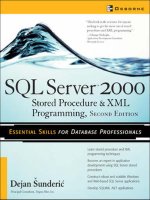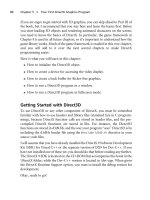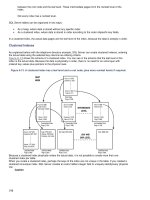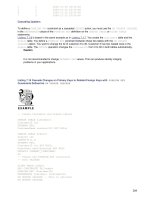SQL Server 2000 Stored Procedure Programming phần 3 ppsx
Bạn đang xem bản rút gọn của tài liệu. Xem và tải ngay bản đầy đủ của tài liệu tại đây (411.11 KB, 76 trang )
136
SQL Server 2000 Stored Procedure Programming
This type of comment can be nested in another comment defined
with the same or a different method:
select * from Equipment –- Just for debugging
This commenting method is compatible with the SQL-92 standard.
Multi-Line Comments—/* … */
The second commenting method is native to SQL Server. It is suitable
for commenting out blocks of code that can span multiple lines. Such
a comment must be divided from the rest of the code with a pair of
delimiters: (/*) and (*/):
/*
This is a comment.
All these lines will be ignored.
*/
/* List all equipment. */
select * from Equipment
Comments do not have a length limit. It is best to write as much
as is necessary to adequately document the code.
SQL Server documentation forbids the nesting of multi-line
comments. In different versions and in different tools this may or
may not generate a syntax error:
/* This is a comment.
/* Query Analyzer will understand the following delimiter
as the end of the first comment. */
This will generate a syntax error in some cases. */
Select * from Equipment
If you type this code in Query Analyzer, the program will not
color the last line of explanation as a comment. (I am not sure you
will be able to see a difference on the paper.) However, during
the execution in Query Analyzer, the third line of the comment is
ignored and will return a resultset without reporting a syntax
error (see Figure 4-1).
Chapter 4: Basic Transact-SQL Programming Constructs
137
Single-line comments can be nested inside multi-line comments:
/*
List all equipment.
Select * from Equipment
*/
In Chapter 6, when we discuss batches, we will illustrate the
requirement that multi-line comments not span two or more batches.
Documenting Code
Again, your comments will be of benefit to other developers who
may read your code, and they will be better still if you make their
presence in the code as obvious as possible. It is a favorable, although
Figure 4-1. Problems with comments
not required, practice to accompany comment delimiters with a full
line of stars, or to begin each commented line with two stars:
/*****************************************************************
** File: prInsertEquipment.sql
** Name: prInsertEquipment
** Desc: Insert equipment and equipment type
** (if not present).
**
** Return values: ErrorCode
**
** Called by: middleware
**
** Parameters:
** Input Output
**
** Make EqId
** Model
** EqType
**
** Auth: Dejan Sunderic
** Date: 1/1/2000
******************************************************************
** Change History
******************************************************************
** Date: Author: Description:
**
** 11/1/2000 DS Fixed:49. Better error handling.
** 11/2/2000 DS Fixed:36. Optimized for performance.
*****************************************************************/
Inserting two stars at the beginning of each line serves two purposes:
▼
They are a visual guide for your eye. If you comment out code
this way, you will not be in doubt whether a piece of code is
functional or commented out.
▲
They will force SQL Server to report a syntax error if
somebody makes an error (for example by nesting comments
or by spanning comments over multiple batches).
138
SQL Server 2000 Stored Procedure Programming
Chapter 4: Basic Transact-SQL Programming Constructs
139
The preceding example is based on part of a SQL script for
creating a stored procedure generated by Visual InterDev. It is very
useful to keep track of all these items explicitly, especially Description
and Change History. It is a personal choice to be more elaborate in
describing stored procedures, but if you are, your comments can
be used as instant design documentation.
Occasionally, developers believe that this type of header is
sufficient code documentation, but you should consider commenting
your code throughout. It is important to comment not how things are
being done, but what is being done. We recommend that you write
your comments to describe what a piece of code is attempting to
accomplish, then write the code itself. In this way, you create design
documentation that eventually becomes code documentation.
Statement Blocks—
Begin … End
The developer can group several Transact-SQL statements by
using Begin … End statements in a logical unit. Such units are
then typically used in flow-control statements to execute a group of
Transact-SQL statements together. Flow-control statements like If,
Case, and While can incorporate a single statement or a statement
block to be executed when certain conditions are met.
Begin
Transact-SQL statements
End
There must be one or more Transact-SQL statements inside a
block. If there is only one statement inside, you could remove the
Begin and End keywords. Begin and End must be used as a pair.
Alone, they are meaningless. If a compiler does not find a matching
pair, it will report a syntax error.
Begin and End can also be nested, but this practice is prone
to errors. However, if you are cautious and orderly, there should
not be a problem. An excellent way to avoid such problems is to
indent the code:
140
SQL Server 2000 Stored Procedure Programming
Begin
Insert Order(OrderDate, RequestedById,
TargetDate, DestinationLocation)
Values(@OrderDate, @ContactId,
@TargetDate, @LocId)
Select @ErrorCode = @@Error,
@OrderId = @@Identity
if @ErrorCode <> 0
begin
RaiseError('Error occurred while inserting Order!', 16,1)
Return @@ErrorCode
end
End
Conditional Execution—the
If
Statement
The If statement is the most common flow control statement. It is
used to examine the value of a condition and to change the flow of
code based on the condition. First, let us review its syntax.
If
boolean_expression
{
Transact-SQL_statement
|
statement_block
}
[else
{
Transact-SQL_statement
|
statement_block
}]
When the server encounters such a construct, it examines the
value of the Boolean expression. If this value is True (1), it executes
the statements or the statement block that follows it. The Else
component of the statement is optional. It includes a single statement
or a statement block that will be executed if the Boolean expression
returns a value of False (0).
NOTE:
The most common mistake made by users of Visual Basic or
other programming languages is to place a delimiter to finish the statement
(i.e.,“endif”). Note also that the Boolean expression must not be followed
by “then” (another VB artifact).
The following code sample tests the value of the @ErrorCode
variable. If the variable does not contain a zero, the server inserts a
record in the Order table and then records the value of the identity
key and any error that may have occurred in the process.
If @ErrorCode <> 0
Begin
Insert Order(OrderDate, RequestedById,
TargetDate, DestinationLocation)
Values(@dtOrderDate, @intContactId,
@dtTargetDate, @intLocId)
Select @intErrorCode = @@Error,
@intOrderId = @@Identity
End
Let us take a look at a more complex case. The following stored
procedure will insert a record in the equipment table and return the
ID of the record to the caller. Unfortunately, the user supplies the
equipment type in text form. The stored procedure must then find
out if such an equipment type exists in the database and insert it
if it does not.
Create Procedure prInsertEquipment_1
store values in equipment table.
return identifier of the record to the caller.
(
@chvMake varchar(50),
@chvModel varchar(50),
@chvEqType varchar(30)
)
As
declare @intEqTypeId int,
@intEquipmentId int
read Id of EqType
Select @intEqTypeId
From EqType
Where EqType = @chvEqType
Chapter 4: Basic Transact-SQL Programming Constructs
141
does such eqType already exists in the database
If @intEqTypeId IS NOT NULL
insert equipment
Insert Equipment (Make, Model, EqTypeId)
Values (@chvMake, @chvModel, @intEqTypeId)
Else
if it does not exist
Begin
insert new EqType in the database
Insert EqType (EqType)
Values (@chvEqType)
get id of record that you've just inserted
Select @intEqTypeId = @@identity
insert equipment
Insert Equipment (Make, Model, EqTypeId)
Values (@chvMake, @chvModel, @intEqTypeId)
End
Select @intEquipmentId = @@identity
return id to the caller
return @intEquipmentId
There are a few items that could be changed in this stored procedure,
but the importance of this example is to illustrate a use of the Else
statement.
One item that could be improved upon is the process of
investigating the EqType table with the Exists keyword. Its use
here is similar to its use in the Where clause:
If [NOT] Exists(subquery)
{Transact-SQL_statement | statement_block}
[else
{Transact-SQL_statement | statement_block}]
Such a statement tests for the presence of the records in the
subquery.
142
SQL Server 2000 Stored Procedure Programming
The stored procedure prInsertEquipment can be modified to use
the Exists keyword:
. . .
If Exists (Select EqTypeId From EqType Where EqType = @chvEqType)
. . .
Naturally, if you use the Not operator, the encapsulated
statement will be executed if the subquery does not return records:
Alter Procedure prInsertEquipment_2
store values in equipment table.
return identifier of the record to the caller.
(
@chvMake varchar(50),
@chvModel varchar(50),
@chvEqType varchar(30)
)
As
declare @intEqTypeId int,
@intEquipmentId int
does such eqType already exists in the database
If Not Exists (Select EqTypeId From EqType Where EqType = @chvEqType)
if it does not exist
Begin
insert new EqType in the database
Insert EqType (EqType)
Values (@chvEqType)
get id of record that you've just inserted
Select @intEqTypeId = @@identity
End
else
read Id of EqType
Select @intEqTypeId
From EqType
Where EqType = @chvEqType
insert equipment
Insert Equipment (Make, Model, EqTypeId)
Values (@chvMake, @chvModel, @intEqTypeId)
Chapter 4: Basic Transact-SQL Programming Constructs
143
Select @intEquipmentId = @@identity
return id to the caller
Return @intEquipmentId
If statements can be nested. In fact, both If and Else can
be nested:
Create Procedure prInsertEquipment_3
store values in equipment table.
return identifier of the record to the caller.
(
@chvMake varchar(50),
@chvModel varchar(50),
@chvEqType varchar(30),
@intEquipmentId int
)
As
declare @intEqTypeId int,
@ErrorCode int
does such eqType already exists in the database
If Not Exists (Select EqTypeId From EqType Where EqType = @chvEqType)
if it does not exist
Begin
insert new EqType in the database
Insert EqType (EqType)
Values (@chvEqType)
get id of record that you've just inserted
Select @intEqTypeId = @@identity,
@ErrorCode = @@Error
If @ErrorCode <> 0
begin
Select 'Unable to insert Equipment Type. Error: ',
@ErrorCode
Return 1
End
End
Else
Begin
read Id of EqType
144
SQL Server 2000 Stored Procedure Programming
Select @intEqTypeId
From EqType
Where EqType = @chvEqType
Select @ErrorCode = @@Error
If @ErrorCode <> 0
begin
Select 'Unable to get Id of Equipment Type. Error: ',
@ErrorCode
Return 2
End
End
insert equipment
Insert Equipment (Make, Model, EqTypeId)
Values (@chvMake, @chvModel, @intEqTypeId)
Select @ErrorCode = @@Error
If @ErrorCode <> 0
Begin
Select 'Unable to insert Equipment. Error: ', @ErrorCode
Return 3
End
return id to the caller
Select @intEquipmentId = @@identity
Return 0
There is no limit to the number of levels. However, this capability
should not be abused. The presence of too many levels is a sure sign
that a more in-depth study should be made concerning code design.
Looping—the
While
Statement
Transact-SQL contains only one statement that allows looping:
While Boolean_expression
{sql_statement | statement_block}
[Break]
Chapter 4: Basic Transact-SQL Programming Constructs
145
146
SQL Server 2000 Stored Procedure Programming
{sql_statement | statement_block}
[Continue]
If the value of the Boolean expression is True (1), the server will
execute one or more encapsulated Transact-SQL statement(s). From
inside the block of statements, this execution can be controlled with
the Break and Continue statements. The server will interrupt the
looping when it encounters a Break statement. When the server
encounters a Continue statement, it will ignore the rest of the
statements and restart the loop.
NOTE:
Keep in mind that loops are primarily tools for third-generation
languages. In such languages, code was written to operate with records
one at a time. Transact-SQL is a fourth-generation language and is written
to operate with sets of information. It is possible to write code in Transact-SQL
that will loop through records and perform operations on a single record, but
you pay for this feature with severe performance penalties. However, there
are cases when such an approach is necessary.
It is not easy to find bona fide examples to justify the use of loops
in Transact-SQL. Let us investigate a stored procedure that calculates
the factorial of an integer number:
Create Procedure prCalcFactorial
calculate factorial
1! = 1
3! = 3 * 2 * 1
n! = n * (n-1)* . . . 5 * 4 * 3 * 2 * 1
@N tinyint,
@F int OUTPUT
As
Set @F = 1
while @N > 1
begin
set @F = @F * @N
Set @N = @N - 1
end
return 0
Chapter 4: Basic Transact-SQL Programming Constructs
147
Another example could be a stored procedure that returns a list of
properties assigned to an asset in the form of a string:
Create Procedure GetInventoryProperties
/*
Return comma-delimited list of properties that are describing asset.
i.e.: Property = Value Unit;Property = Value Unit;Property = Value
Unit;Property = Value Unit;Property = Value Unit;
*/
(
@intInventoryId int,
@chvProperties varchar(8000) OUTPUT
)
As
declare @intCountProperties int,
@intCounter int,
@chvProperty varchar(50),
@chvValue varchar(50),
@chvUnit varchar(50)
Create table #Properties(
Id int identity(1,1),
Property varchar(50),
Value varchar(50),
Unit varchar(50))
identify Properties associated with asset
insert into #Properties (Property, Value, Unit)
select Property, Value, Unit
from InventoryProperty inner join Property
on InventoryProperty.PropertyId = Property.PropertyId
where InventoryProperty.InventoryId = @intInventoryId
set loop
select @intCountProperties = Count(*),
@intCounter = 1,
@chvProperties = ''
from #Properties
loop through list of properties
while @intCounter <= @intCountProperties
148
SQL Server 2000 Stored Procedure Programming
begin
get one property
select @chvProperty = Property,
@chvValue = Value,
@chvUnit = Unit
from #Properties
where Id = @intCounter
assemble list
set @chvProperties = @chvProperties + '; '
+ @chvProperty + '='
+ @chvValue + ' ' + @chvUnit
let's go another round and get another property
set @intCounter = @intCounter + 1
end
drop table #Properties
return 0
Unconditional Execution—the
GoTo
Statement
The GoTo statement forces the server to continue the execution
from a label:
GoTo
label
label
:
The label has to be within the same stored procedure or batch. It is
not important whether the label or the GoTo statement is defined first
in the code. The label can even exist without the GoTo statement to
which it is pointing. Naturally, the server will report an error if it
encounters a GoTo statement that points to a nonexistent label.
The following stored procedure uses the GoTo statement to
interrupt further processing and display a message to the user when
an error occurs:
Create Procedure prCloseLease
Clear Rent, ScheduleId, and LeaseId on all assets associated
Chapter 4: Basic Transact-SQL Programming Constructs
149
with specified lease.
@intLeaseId int
As
delete schedules
Update Inventory
Set Rent = 0,
LeaseId = null,
LeaseScheduleId = null
Where LeaseId = @intLeaseId
If @@Error <> 0 Goto PROBLEM
delete schedules
Delete from LeaseSchedule
Where LeaseId = @intLeaseId
If @@Error <> 0 Goto PROBLEM
delete lease
Delete from Lease
Where LeaseId = @intLeaseId
If @@Error <> 0 Goto PROBLEM
Return 0
PROBLEM:
Select 'Unable to remove lease from the database!'
Return 1
To
GoTo
or Not to
GoTo
—That Is the Question
The use of the GoTo statement is a very controversial issue. For
example, if a language contains an If statement and a GoTo statement,
all other flow-control statements are optional. On the other hand,
extensive use of the GoTo statement leads to unmanageable code
often referred to as “spaghetti code” (see Figure 4-2).
A stigma became attached to the GoTo statement shortly after
Edsger Dijkstra published a paper entitled “Go To Statement
Considered Harmful” in Communications of the ACM in 1968.
He observed that the number of GoTo statements in a body
of code is inversely proportional to the quality of the code.
150
SQL Server 2000 Stored Procedure Programming
Figure 4-2. Spaghetti code
Intense discussions followed for many years and brought to
light the following points:
▼
Code that does not contain a GoTo statement is easier to read
and understand. Code that uses GoTo statements is also
difficult to format in a manner that emphasizes its logical
structure.
■
The use of GoTo statements sometimes leads the compiler to
produce a slower and larger executable.
■
The use of GoTo statements tends to spread like termites. If
their use is allowed in the environment, pretty soon they will
appear both where they should and where they should not.
■
Code that does not contain GoTo statements is easier to debug
and test.
▲
The use of GoTo statements contradicts the principles of
structured programming.
The question is: Should the GoTo statement be used? In my
opinion, the overuse of GoTo statements is more a symptom than a
cause of low-quality code. In some cases, their use is justified, but the
developer must be sure that such is the case and that it is not possible
to produce a better solution using other programming constructs.
For example, the following loop can be implemented using GoTo,
but I recommend that you use While instead:
Create Procedure prLoopWithGoTo
just an example how to implement loop using If and Goto
As
declare @MaxCounter int,
@Counter int
Select @MaxCounter = Max(EquipmentId),
@Counter = 1
from Equipment
LOOP:
if @Counter < @MaxCounter
begin
Chapter 4: Basic Transact-SQL Programming Constructs
151
152
SQL Server 2000 Stored Procedure Programming
some work
Select @Counter this line is meaningless:
we need to do something to demonstrate loop
set @Counter = @Counter + 1
GoTo LOOP
end
The point of this example is not merely to replace the GoTo
statement in a mechanical manner. The point is that use of the While
statement produces code that is much easier to read. Thus, replacing
GoTo with While is a change for the better.
Some database administrators base their error-handling practices
on the use of the GoTo statement. There is an example of this type of
code in the stored procedure prCloseLease shown in the previous
section. This solution is not a perfect one. You will see several other
error-handling solutions in Chapter 7.
Scheduled Execution—the
WaitFor
Statement
There are two ways to schedule the execution of a batch or stored
procedure in SQL Server. One way is based on the use of SQL Server
Agent (a tool formerly known as Task Scheduler). The other way is
to use the WaitFor statement. The WaitFor statement allows the
developer to specify the time when, or a time interval after which,
the remaining Transact-SQL statements will be executed:
WaitFor {Delay '
time
' | Time '
time
'}
There are two variants to this statement. One specifies the delay
(time interval) that must pass before the execution can continue. The
time interval specified as a parameter of the statement must be less
than 24 hours. In the following example, the server will pause for one
minute before displaying the list of Equipment:
WaitFor Delay '00:01:00'
Select * from Equipment
The other variant is more significant. It allows the developer to
schedule a time when the execution is to continue. The following
example runs a full database backup at 11:00
P.M.:
Chapter 4: Basic Transact-SQL Programming Constructs
153
WaitFor Time '23:00'
Backup Database Asset To Asset_bkp
There is one problem with this Transact-SQL statement. The
connection remains blocked while the server waits to execute the
statement. Therefore, it is much better to use SQL Server Agent than
the WaitFor statement to schedule jobs.
CURSORS
Relational databases are designed to work with sets of information
(records). In fact, the purpose of the Select statement, as the most
important statement in SQL, is to define a set of records. In contrast,
end-user applications display information to the user record by
record (or maybe in small batches). To close the gap between these
conflicting requirements, RDBMS architects have invented a new
class of programming constructs—cursors.
Many types of cursors are implemented in various environments
using different syntax, but all cursors work in a similar fashion:
1. A cursor first has to be defined and its features have to be set.
2. The cursor must be populated.
3. The cursor then has to be positioned (scrolled) to a record or
block of records that need to be retrieved (fetched).
4. Information from one or more current records is fetched, and
then some modification can be performed or some action can
be initiated based on the fetched information.
5. Optionally, steps 3 and 4 are repeated.
6. Finally, the cursor must be closed and resources released.
Cursors can be used on both server and client sides. SQL Server
and the APIs for accessing database information (OLE DB, ODBC,
DB-Library) all include sets of functions for processing cursors.
SQL Server supports three classes of cursors:
▼
Client cursors
■
API Server cursors
▲
Transact-SQL cursors
154
SQL Server 2000 Stored Procedure Programming
The major difference between Transact-SQL cursors and other
types of cursors is their purpose. Transact-SQL cursors are used from
stored procedures, batches, functions, or triggers to repeat custom
processing for each row of the cursor. Other kinds of cursors are
designed to access database information from the client application.
We will review only Transact-SQL cursors.
Transact-SQL Cursors
Processing in Transact-SQL cursors has to be performed in the
following steps:
1. Use the Declare Cursor statement to create the cursor
based on the Select statement.
2. Use the Open statement to populate the cursor.
3. Use the Fetch statement to change the current record in the
cursor and to store values into local variables.
4. Do something with the retrieved information.
5. If needed, repeat steps 3 and 4.
6. Close the cursor. Most of the resources (memory, locks…)
will be released.
7. Deallocate the cursor.
NOTE:
Transact-SQL cursors do not support processing blocks of records.
Only one record can be fetched at a time.
It is best to show this process through an example. We will rewrite
the stored procedure that we used to illustrate the use of the While
statement. The purpose of this stored procedure is to collect the
properties of a specified asset and return them in delimited format
(Property = Value Unit;). The final result should look like this:
CPU=Pentium II;RAM=64 MB;HDD=6.4 GB;Resolution=1024x768;Weight=2 kg;
Chapter 4: Basic Transact-SQL Programming Constructs
155
Here is the code for the new instance of the stored procedure:
Alter Procedure prGetInventoryProperties_Cursor
/*
Return comma-delimited list of properties that are describing asset.
Property = Value unit;Property = Value unit;Property = Value unit;
Property = Value unit;Property = Value unit;Property = Value unit;
*/
(
@intInventoryId int,
@chvProperties varchar(8000) OUTPUT,
@debug int = 0
)
As
declare @intCountProperties int,
@intCounter int,
@chvProperty varchar(50),
@chvValue varchar(50),
@chvUnit varchar(50),
@insLenProperty smallint,
@insLenValue smallint,
@insLenUnit smallint,
@insLenProperties smallint
Set @chvProperties = ''
Declare @CrsrVar Cursor
Set @CrsrVar = Cursor For
select Property, Value, Unit
from InventoryProperty inner join Property
on InventoryProperty.PropertyId = Property.PropertyId
where InventoryProperty.InventoryId = @intInventoryId
Open @CrsrVar
Fetch Next From @CrsrVar
Into @chvProperty, @chvValue, @chvUnit
While (@@FETCH_STATUS = 0)
Begin
Set @chvUnit = Coalesce(@chvUnit, '')
If @debug <> 0
Select @chvProperty Property,
@chvValue [Value],
@chvUnit [Unit]
check will new string fit
Select @insLenProperty = DATALENGTH(@chvProperty),
@insLenValue = DATALENGTH(@chvValue),
@insLenUnit = DATALENGTH(@chvUnit),
@insLenProperties = DATALENGTH(@chvProperties)
If @insLenProperties + 2 + @insLenProperty + 1 +
@insLenValue + 1 + @insLenUnit > 8000
Begin
Select 'List of properties is too long (> 8000 char)!'
Return 1
End
assemble list
Set @chvProperties = @chvProperties + @chvProperty + '='
+ @chvValue + ' ' + @chvUnit + '; '
If @debug <> 0
Select @chvProperties chvProperties
Fetch Next From @CrsrVar
Into @chvProperty, @chvValue, @chvUnit
End
Close @CrsrVar
Deallocate @CrsrVar
Return 0
The stored procedure will first declare a cursor:
Declare @CrsrVar Cursor
156
SQL Server 2000 Stored Procedure Programming
Chapter 4: Basic Transact-SQL Programming Constructs
157
The cursor will then be associated with the collection of Properties
related to the specified asset:
Set @CrsrVar = Cursor For
Select Property, Value, Unit
From InventoryProperty inner join Property
On InventoryProperty.PropertyId = Property.PropertyId
Where InventoryProperty.InventoryId = @intInventoryId
Before it can be used, the cursor needs to be opened:
Open @CrsrVar
The content of the first record can then be fetched into local
variables:
Fetch Next From @CrsrVar
Into @chvProperty, @chvValue, @chvUnit
If the fetch was successful, we can start a loop to process the
complete recordset:
While (@@FETCH_STATUS = 0)
After the values from the first record are processed, we read the
next record:
Fetch Next From @CrsrVar
Into @chvProperty, @chvValue, @chvUnit
Once all records have been read, the value of @@fetch_status
is set to –1 and we exit the loop. We need to close and deallocate the
cursor and finish the stored procedure.
Close @CrsrVar
Deallocate @CrsrVar
Now, let’s save and execute this stored procedure:
Declare @chvRes varchar(8000)
Exec prGetInventoryProperties_Cursor 5, @chvRes OUTPUT
Select @chvRes Properties
158
SQL Server 2000 Stored Procedure Programming
SQL Server will return the following:
Properties
CPU=Pentium II ; RAM=64 MB; HDD=6.4 GB; Resolution=1024x768 ; Weight
=2 kg; Clock=366 MHz;
Cursor-Related Statements and Functions
Let’s review statements and functions that you need to utilize to
control cursors.
The
Declare Cursor
Statement
This statement declares the Transact-SQL cursor and specifies its
behavior and the query on which it is built. It is possible to use
syntax based on the SQL-92 standard or native Transact-SQL syntax.
We will display only the simplified syntax. If you need more details,
refer to SQL Server Books Online.
Declare
cursor_name
Cursor
For
select_statement
The name of the cursor is an identifier that complies with the
rules set for local variables.
The
Open
Statement
The Open statement executes the Select statement specified in the
Declare Cursor statement and populates the cursor:
Open { { [Global]
cursor_name
} |
cursor_variable_name
}
The
Fetch
Statement
The Fetch statement reads the row specified in the Transact-SQL
cursor.
Fetch [ [ Next | Prior | First | Last
| Absolute {
n
| @
nvar
}
| Relative {
n
| @
nvar
}
]
From
]
{ { [Global]
cursor_name
} | @
cursor_variable_name
}
[Into @
variable_name
[,
n
] ]
This statement can force the cursor to position the current record
at the Next, Prior, First, or Last record. It is also possible to
specify the Absolute position of the record or a position Relative
to the current record.
If the developer specifies a list of global variables in the
Into clause, those variables will be filled with values from the
specified record.
If the cursor has just been opened, you can use Fetch Next to
read the first record.
@@fetch_status
@@fetch_status is a function (or global variable) that returns the
success code of the last Fetch statement executed during the current
connection. It is often used as an exit criterion in loops that fetch
records from a cursor.
Success
Code Description
0 Fetch was completely successful.
–1 Fetch statement tried to read a record outside the
recordset (last record was already read) or fetch
statement failed.
–2 Record is missing (for example, somebody else has
deleted the record in the meantime).
@@cursor_rows
As soon as the cursor is opened, the @@cursor_rows function (or
global variable) is set to the number of records in the cursor (you can
use this variable to loop through the cursor also).
Chapter 4: Basic Transact-SQL Programming Constructs
159
The
Close
Statement
This statement closes an open cursor, releases the current recordset,
and releases locks on rows held by the cursor:
Close { { [Global]
cursor_name
} |
cursor_variable_name
}
This statement must be executed on an opened cursor. If the
cursor has just been declared, SQL Server will report an error.
The
Deallocate
Statement
After the Close statement, the structure of the cursor is still in place.
It is possible to open it again. If you do not plan to use it any more,
you should remove the structure as well:
Deallocate { { [Global]
cursor_name
} | @
cursor_variable_name
}
Problems with Cursors
Cursors are a valuable but dangerous tool. Their curse is precisely
the problem they are designed to solve—the differences between the
relational nature of database systems and the record-based nature of
client applications.
First of all, cursors are procedural and thus contradict the basic
idea behind the SQL language—that is, to define what is needed in
a result, not how to get it.
Performance penalties are an even larger problem. Regular SQL
statements are set-oriented and much faster. Some types of cursors
lock records in the database and prevent other users from changing
them. Other types of cursors create an additional copy of all records
and then work with them. Both approaches have performance
implications.
Client-side cursors and API Server cursors are also not the most
efficient way to transfer information between server and client. It
is much faster to use a “fire hose” cursor, which is actually not a
cursor at all. You can find more details about “fire hose” cursors
in Hitchhiker’s Guide to Visual Basic and SQL Server, 5th edition by
William Vaughn (Microsoft Press).
160
SQL Server 2000 Stored Procedure Programming









